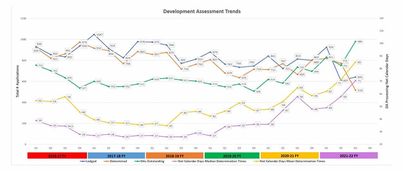
Photo: Cr Turley at the LG NSW conference in 2022.
“Perhaps the most consistent message I hear from my discussions with members is the continuing erosion of local democracy by the State Government,” says the president of Local Government NSW, Darriea Turley.
Cr Turley, a councillor at Broken Hill, said cost shifting was one example of the phenomenon, but the results could be just as clearly seen in the planning process.
“Our communities have less and less say in the future of their neighbourhoods, as a range of so-called “reforms” transfer power from the people who live in the area towards big development,” Cr Turley said.
“The latest example is the NSW Government’s Rezoning Pathways Program, announced in December, which invited developers to put forward rezoning proposals for large developments right across NSW, without councils or communities running a critical eye over them.”
Cr Turley said the NSW Government was assessing these developer proposals, having once again sidelined the crucial role of councils in strategic planning.
Speaking in her regular President’s Message, on February 7, Cr Turley also criticised another recent NSW Government announcement that it intends to establish a series of taskforces to cut red tape if re-elected following the March election, with an initial focus on local government and small business.
“Make no mistake: as councils we welcome sensible efforts to streamline regulation and prime the pumps of our local economies,” Ms Turley said.
“The problem is that “cutting red tape” is too often a euphemism.
“Streamlining regulation should never mean the reckless removal of council approvals that exist for good reasons: safety, public amenity, accessibility, protection of the environment and consistency with strategic planning that has been undertaken in consultation with the community,” she said.
She said the NSW Government should focus on the Planning Portal.
Councils across NSW report major challenges with the Portal’s operation since it was made mandatory in 2020, with some councils advising it was adding up to 14 days to DA assessment timeframes.
Here on the Central Coast, the time development applications (DA) are taking is not known.
The last time the public was updated on DA times was in July 2022 and that report related to times up to March 2022.
At that time, the time it took to get a DA approved was increasing and Council said it was significantly up from the previous year due to a reduction in staff numbers.
Median processing times was 47 days for the October 2021 to March 2022 period (net calendar days) according to the written report tabled at the meeting.
However, a graph attached to the report shows the median time was 71 days.
The total number of development applications outstanding at the end of that period was 980 (an increase from 831 outstanding applications as at 30 September 2021).
At the July 26, 2022, meeting, administrator Rik Hart said that, on the surface, the trends were concerning but he was happy to hear another 14 people were being recruited and that would make a difference.
He said he would hope to see an improvement or he would have to ask why.
There has been no DA report tabled at a Council meeting since then.
When a resident recently asked why, they were told it was delayed.
Below is the graph from the July 2022 meeting.



